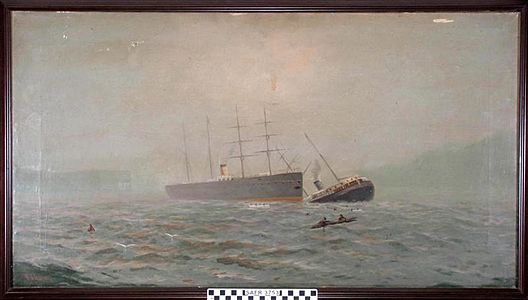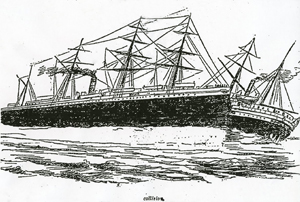SS City of Chester facts for kids
Quick facts for kids History |
|
|---|---|
| Name | SS City of Chester |
| Owner | Oregon Railroad Co. |
| Operator | Pacific Coast Steamship Company |
| Port of registry | Portland, Oregon |
| Builder | John Roach & Sons, Chester, Pennsylvania |
| Completed | 1875 |
| Identification |
|
| Fate | Sunk in collision 22 August 1888 |
| Notes | Sometimes confused with 1872 City of Chester also built Chester, Pa., O/N 125002, 153.78 GRT, 107 feet (33 m) length registered at New York, N.Y. |
| General characteristics | |
| Type | Steamship |
| Tonnage | 1,106.21 GRT, 785.33 NRT |
| Length | 202 feet (62 m) |
| Beam | 33.2 ft (10.1 m) |
| Depth | 15.9 feet (4.8 m) |
| Installed power | 2 X 11 ft 6 in (3.5 m) long boilers, 1 X 9 ft 6 in (2.9 m), 1 X 12 ft 6 in (3.8 m) diameter |
| Propulsion |
|
| Speed | 11 nmi (13 mi; 20 km) |
| Capacity | Passengers: 114 first class, 200 steerage |
The SS City of Chester was a large steamship built in 1875. It tragically sank after crashing into another ship, the RMS Oceanic, on August 22, 1888. This accident happened in a very thick fog near the Golden Gate in San Francisco Bay. The City of Chester was owned by the Oregon Railroad Co. and was being used by the Pacific Coast Steamship Company.
The City of Chester was bought in October 1876. It sailed all the way from New York, around the bottom of South America, to Portland, Oregon, arriving in March 1877. It was then used to carry goods and people along the coast. At the time of the crash, the ship was traveling from San Francisco to Eureka and other nearby places. The City of Chester was leaving San Francisco, while the Oceanic was arriving from Hong Kong. Even though both ships saw each other, the smaller City of Chester was pulled by a strong tidal current. It was cut almost in half by the much larger Oceanic. The ship sank in about six minutes. Sadly, sixteen passengers and three crew members lost their lives.
In May 2013, the shipwreck was found again. A special team from NOAA used advanced sonar technology to locate it.
Contents
Building the City of Chester
The City of Chester was built in 1875. It was constructed by a company called John Roach & Sons in Chester, Pennsylvania. The ship was quite large, measuring 202 feet (62 m) long. It was 33.2 feet (10.1 m) wide and 15.9 feet (4.8 m) deep. The ship had two boilers and a powerful steam engine. This engine could produce 600 horsepower. The City of Chester was officially registered in Portland, Oregon. Its U.S. Official Number was 125473.
The Ship's Journey and Work
The Oregon Steamship Company bought the City of Chester in October 1876. It was meant to replace another steamer called the John L. Stephnes. The ship left New York on December 29, 1876. It was heading for San Francisco. This ship was the first to use a new channel through Hell Gate in the East River. Then, it sailed around South America through the Strait of Magellan.
After some repairs in San Francisco, the ship left for Portland, Oregon. This happened on March 24, 1877. In 1879, the Oregon Steamship Company joined with another company. They formed the Oregon Railway and Navigation Company. The City of Chester was mainly used for trade along the coast.
When the collision happened, the ship was rented to the Pacific Coast Steamship Company. Its usual trip was from San Francisco's Broadway Wharf. It would leave on Wednesdays for Eureka, Arcata, and Fields Landing. These towns are all located on Humboldt Bay. The ship would then return from Eureka on Saturdays.
The Tragic Sinking
On the foggy morning of August 22, 1888, the City of Chester was sailing to Eureka, California. There were 90 passengers on board. Around 10 am, it crashed into the Oceanic. The Oceanic was a large ship coming from Hong Kong. Both ships saw each other in the fog. However, a British Naval Court later found that the City of Chester was pulled by a strong tidal current. This current pushed it right into the path of the much bigger Oceanic.
An eyewitness on the Oceanic described the crash. They said the Oceanic hit the City of Chester with great force. It cut through the smaller ship "just as though she was a cheese." The City of Chester sank very quickly, in just six minutes. People on the Oceanic tried their best to rescue survivors. Despite their efforts, sixteen passengers and three crew members died. Among the passengers were two children. This event was one of the deadliest shipwrecks in San Francisco Bay's history. Only the sinking of the SS City of Rio de Janeiro in 1901 was worse.
The Oceanic had a Chinese crew. Many of its passengers were Chinese immigrants. At that time, there was a lot of unfair treatment against Chinese people in the U.S. Because of this, some people first blamed the Chinese crew. They wrongly accused them of letting the City of Chester passengers drown. But when news came out about how hard the Chinese crew worked to save people, it helped to reduce some of that unfair prejudice.
Finding the Wreck
The wreck of the City of Chester is located 216 feet (66 m) deep in the water. It lies just inside the Golden Gate Bridge. Its exact location is 37°48′50″N 122°28′00″W / 37.81389°N 122.46667°W. The wreck was found in May 2013 by a team from NOAA. They used special multi-beam sonar equipment.
Interestingly, the wreck was found only 400 feet (120 m) from where it was first located. A group that came before NOAA, the U.S. National Geodetic Survey, found it in September 1888. They used a wire dragged from a tugboat called the Raymond.
An exhibit about the City of Chester is planned. It will be at the Gulf of the Farallones National Marine Sanctuary office. This office is at Crissy Field. The building itself was built as a lifesaving station. It was created in response to this very disaster.
Gallery
-
An illustration of the collision from the San Francisco Chronicle newspaper.




